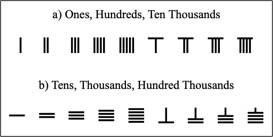- About MAA
- Membership
- MAA Publications
- Periodicals
- Blogs
- MAA Book Series
- MAA Press (an imprint of the AMS)
- MAA Notes
- MAA Reviews
- Mathematical Communication
- Information for Libraries
- Author Resources
- Advertise with MAA
- Meetings
- Competitions
- Programs
- Communities
- MAA Sections
- SIGMAA
- MAA Connect
- Students
- MAA Awards
- Awards Booklets
- Writing Awards
- Teaching Awards
- Service Awards
- Research Awards
- Lecture Awards
- Putnam Competition Individual and Team Winners
- D. E. Shaw Group AMC 8 Awards & Certificates
- Maryam Mirzakhani AMC 10 A Awards & Certificates
- Two Sigma AMC 10 B Awards & Certificates
- Jane Street AMC 12 A Awards & Certificates
- Akamai AMC 12 B Awards & Certificates
- High School Teachers
- News
You are here
Reflections on Chinese Numeration Systems: What Are Rod Numerals?
The accomplishments of ancient Chinese mathematicians have increasingly come to light since [Needham 1954] started to bring them to the attention of Western historians, with [Dauben 2007] providing an account of the culture’s global context that is especially useful for students and instructors. It can be argued that the utilitarian mathematics of ancient China exceeded that of the West, both in scope and quality, up to the time of the European Renaissance. The Chinese could extract square and cube roots of numbers to several decimal places, and by 500 CE they had obtained a value for \(\pi\) of \(3.14159267\), a degree of precision unknown elsewhere until after the 16th century.
Fundamental to this high level of achievement was the facility of the Chinese system of numbers and notation. From the 8th century BCE forward, they employed a decimal number system that utilized place value ordering. The numerals were written as vertical and horizontal strokes that depicted a configuration of bamboo rods, or suanzi, organized into two distinct but related sets of figures.

Figure 2. The two sets of rod numerals. Figure drawn by the author.
The first set (Figure 2a), called zeng by the Chinese, was used to denote even powers of ten: units, hundreds, ten thousands. . . . The second set (Figure 2b), hang, represented odd powers of ten: tens, thousands, hundred thousands. . . . While computing rods were initially made of bamboo, later rods were made of bone, ivory, or even jade. As conceived, the rod numerals possessed certain properties:
- Rod numerals 1–5 are obviously simple tally symbols or stroke marks, by which a 1:1 correspondence is established between the objects being counted and the recording strokes. The symbols change to a coded symbol after a count of 5. Coded symbols are comprised of a horizontal stroke representing 5 combined with simple vertical tally strokes. A close association with hand counting is evident.
- The symbols used to represent powers of ten are single strokes—either horizontal or vertical. Rod numeration is clearly decimal in nature and employs a positional ordering based on powers of ten.
- The positional ordering in rod numeration follows modern conventions. Chinese mathematicians used decimal-based, place-value systems of recording numbers well before the Common Era.
In situations involving numerical problem-solving, computations were performed on a flat surface: the floor, a tabletop, or even a separate board, using a set of bamboo rods (approximately 13 cm long). Rod configurations representing numerical quantities were laid out horizontally from the right to the left in ascending powers of ten, in contrast to traditional Chinese textual writing, which proceeded vertically from the top of a page to the bottom. In the computational process, vertical columns were used to ensure place value, and mathematical operations proceeded downward within columns. Thus, the computing surface was partitioned into a grid in which each cell could, or did, contain a rod configuration. As shown in Figure 3, some existing woodcut prints depict computing situations. When the results of computations were written out, the rod configurations were copied, giving rise to the set of rod numerals.

Figure 3. A mathematician performs rod calculations before his master.
Japanese wood cut print by Seijutsu Sangaku Zue, 1795. Wikimedia Commons.
This system of computation and number recording was greatly admired throughout East Asia. Mathematicians in both Korea and Japan adopted the use of computing rods, sangi, and their numerical interpretation. Rod numerals can be read in a manner similar to our modern numerals.

Figure 4. Place value chart for rod numerals. Figure drawn by the author.
The rod positions in the top row represent the number \(548\), in the second row \(2763\), and in the bottom row \(114\).
Thus, these numerals evolved directly from a system of concrete counting and computing. For today’s students, too, they supply a semi-concrete image of mathematical relationships and, as such, provide working models for numbers. Numerical relationships are intrinsically embedded in the numerals themselves and encourage mathematical understanding, an attractive pedagogical feature.
Frank J. Swetz (The Pennsylvania State University), "Reflections on Chinese Numeration Systems: What Are Rod Numerals?," Convergence (February 2022)




